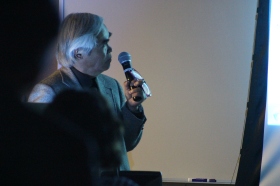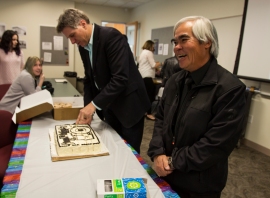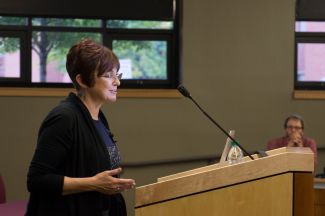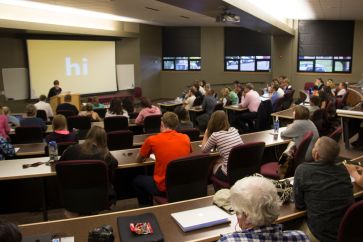When airplanes flew low over Nick Ut’s home in Los Angeles, California, his house shook and reminded him of the Vietnam War. Born in Long An, Vietnam, Ut started working for the Associated Press (AP) when he was 16 years old, following in the footsteps of his older brother who had recently died while on assignment in 1965. Ut inherited his brother’s cameras and taught himself photography by working in the AP’s darkroom and shooting protests in Saigon.
His editors’ quickly recognized Ut’s skill and sent him into the field to cover the Vietnam War. Ut’s brother’s voice echoed in his head. “I make a picture for you, my brother, to change the war,” Ut said.

Ut spoke at the University of Montana on March 9, as part of the 100-year anniversary of the Pulitzer Prize and to celebrate his 50 years working for the AP. In 1973, just 21 years old, Ut won the Pulitzer Prize for Spot News Photography. He called the picture “The Terror of War,” but others referred to it as “The Napalm Girl.” Dean of the School of Journalism, Larry Abramson, walked past that picture dozens of times, printed on flyers, in the weeks leading up to Ut’s visit. “Even on the Xerox copy, I’d stop and see something new every day,” Abramson said.
The picture features children running down a road in Trang Bang, Vietnam after a napalm attack on the village. The “Napalm Girl” was Phan Thj Kim Phuc, who ran away from the village, arms outstretched and completely naked. Ut shot several frames of her and the other children fleeing before he understood how badly Phuc had been burned by the attack.
“I saw skin coming off her body,” Ut said. “And I thought, oh my God, I don’t want her to die.”
Ut set his cameras aside and started dumping water on Phuc to try and help her. However, he knew that Phuc and the other children needed professional help, so he transported them in the AP van to the nearest hospital. Since then, Ut said, “I keep looking to help the children.”
He’s sent food and clothing to families in Vietnam impacted by the use of Agent Orange, and he’s kept track of Phuc since the day of the attack on June 8th, 1972. Phuc began to refer to Ut as “Uncle Nick” over the years, as he continued to photograph her skin’s recovery and support her as a current U.N. Goodwill Ambassador. Thanks to Ut’s photos, the two have also spoken to media around the world about the cruelties of war. Ut said, “We met the Queen of England, me and her.”

Pollner Professor, Sally Stapleton, and Ut’s friend from their shared time at the AP, said, “He takes ‘No means nothing’ better than anyone I know.”
Ut said he’s “always with camera” to be prepared for unexpected stories. In contrast to his time covering war stories, Ut said, “I tell you, Hollywood, it’s a lot of fun.” Now based in Los Angeles, Ut’s shot court cases involving Michael Jackson, Lindsay Lohan and Paris Hilton. He also captured the “Super Blood Moon” of 2015 and unexpected L.A.P.D. street arrests.
For the UM journalism students in the audience, Ut said the key to a great photo evolves from four elements: keep moving, try different angles, keep shooting and capture different emotions.
The next pressing assignment for Ut will be covering Nancy Reagan’s funeral Friday, March 12th.
Stay up-to-date with Ut’s work by following his Twitter and Instagram accounts.
by Jana Wiegand


